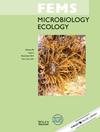Microbial Ecology of Nitrate-, Selenate-, Selenite-, and Sulfate-Reducing Bacteria in a H2-Driven Bioprocess
IF 3.2
3区 生物学
Q2 MICROBIOLOGY
引用次数: 0
Abstract
A hydrogen (H2)-based membrane biofilm reactor (H2-MBfR) can reduce electron acceptors nitrate (NO3−), selenate (SeO42−), selenite (HSeO3−), and sulfate (SO42−), which are in wastewaters from coal mining and combustion. This work presents a model to describe a H2-driven microbial community comprised of hydrogenotrophic and heterotrophic bacteria that respire NO3−, SeO42−, HSeO3−, and SO42−. The model provides mechanistic insights into the interactions between autotrophic and heterotrophic bacteria in a microbial community that is founded on H2-based autotrophy. Simulations were carried out for a range of relevant solids retention times (0.1 to 20 days) and with adequate H2-delivery capacity to reduce all electron acceptors. Bacterial activity began at an ∼0.6-day SRT, when hydrogenotrophic denitrifiers began to accumulate. Selenate-reducing and selenite-reducing hydrogenotrophs became established next, at SRTs of ∼1.2 and 2 days, respectively. Full nitrate, selenate, and selenite reductions were complete by an SRT of ∼5 days. Sulfate reduction began at an SRT of ∼10 days and was complete by ∼15 days. The desired goal of reducing nitrate, selenate, and selenite, but not sulfate, was achievable within an SRT window of 5 to 10 days. Autotrophic hydrogenotrophs dominated the active biomass, but non-active solids were a major portion of the solids, especially for an SRT ≥ 5 days.H2 驱动的生物过程中硝酸盐、硒、亚硒和硫酸盐还原菌的微生物生态学研究
基于氢气(H2)的膜生物膜反应器(H2-MBfR)可以还原采煤和燃烧废水中的电子受体硝酸盐(NO3-)、硒酸盐(SeO42-)、亚硒酸盐(HSeO3-)和硫酸盐(SO42-)。这项研究提出了一个模型,用于描述一个由养氢菌和异养菌组成的 H2 驱动微生物群落,它们对 NO3-、SeO42-、HSeO3- 和 SO42- 进行呼吸作用。该模型从机理上揭示了以 H2 自养为基础的微生物群落中自养和异养细菌之间的相互作用。模拟在一系列相关的固体滞留时间(0.1 至 20 天)内进行,并有足够的 H2 输送能力来减少所有电子受体。细菌活动始于 0.6 天的 SRT,此时开始积累养氢型反硝化菌。随后,硒酸盐还原型和硒酸盐还原型养氢菌开始出现,SRT 分别为 1.2 天和 2 天。硝酸盐、硒酸盐和亚硒酸盐的完全还原在 SRT 为 5 天时完成。硫酸盐的减少从 10 天的 SRT 开始,到 15 天完成。硝酸盐、硒酸盐和亚硒酸盐的还原,但硫酸盐的还原,可在 5 至 10 天的 SRT 窗口内实现。自养型养氢菌在活性生物量中占主导地位,但非活性固体是固体的主要部分,尤其是在 SRT ≥ 5 天时。
本文章由计算机程序翻译,如有差异,请以英文原文为准。
求助全文
约1分钟内获得全文
求助全文
来源期刊

FEMS microbiology ecology
生物-微生物学
CiteScore
7.50
自引率
2.40%
发文量
132
审稿时长
3 months
期刊介绍:
FEMS Microbiology Ecology aims to ensure efficient publication of high-quality papers that are original and provide a significant contribution to the understanding of microbial ecology. The journal contains Research Articles and MiniReviews on fundamental aspects of the ecology of microorganisms in natural soil, aquatic and atmospheric habitats, including extreme environments, and in artificial or managed environments. Research papers on pure cultures and in the areas of plant pathology and medical, food or veterinary microbiology will be published where they provide valuable generic information on microbial ecology. Papers can deal with culturable and non-culturable forms of any type of microorganism: bacteria, archaea, filamentous fungi, yeasts, protozoa, cyanobacteria, algae or viruses. In addition, the journal will publish Perspectives, Current Opinion and Controversy Articles, Commentaries and Letters to the Editor on topical issues in microbial ecology.
- Application of ecological theory to microbial ecology
- Interactions and signalling between microorganisms and with plants and animals
- Interactions between microorganisms and their physicochemical enviornment
- Microbial aspects of biogeochemical cycles and processes
- Microbial community ecology
- Phylogenetic and functional diversity of microbial communities
- Evolutionary biology of microorganisms
 求助内容:
求助内容: 应助结果提醒方式:
应助结果提醒方式:


